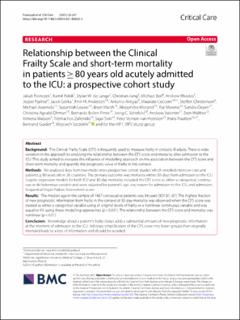| dc.contributor.author | Fronczek, Jakub | |
| dc.contributor.author | Polok, Kamil | |
| dc.contributor.author | de Lange, Dylan W. | |
| dc.contributor.author | Jung, Christian | |
| dc.contributor.author | Beil, Michael | |
| dc.contributor.author | Rhodes, Andrew | |
| dc.contributor.author | Fjølner, Jesper | |
| dc.contributor.author | Górka, Jacek | |
| dc.contributor.author | Andersen, Finn H. | |
| dc.contributor.author | Artigas, Antonio | |
| dc.contributor.author | Cecconi, Maurizio | |
| dc.contributor.author | Christensen, Steffen | |
| dc.contributor.author | Flaatten, Hans | |
| dc.contributor.author | Szczeklik, Wojciech | |
| dc.date.accessioned | 2021-12-15T11:48:28Z | |
| dc.date.available | 2021-12-15T11:48:28Z | |
| dc.date.created | 2021-12-03T14:21:00Z | |
| dc.date.issued | 2021 | |
| dc.identifier.issn | 1364-8535 | |
| dc.identifier.uri | https://hdl.handle.net/11250/2834412 | |
| dc.description.abstract | Background: The Clinical Frailty Scale (CFS) is frequently used to measure frailty in critically ill adults. There is wide variation in the approach to analysing the relationship between the CFS score and mortality after admission to the ICU. This study aimed to evaluate the influence of modelling approach on the association between the CFS score and short-term mortality and quantify the prognostic value of frailty in this context.
Methods: We analysed data from two multicentre prospective cohort studies which enrolled intensive care unit patients ≥ 80 years old in 26 countries. The primary outcome was mortality within 30-days from admission to the ICU. Logistic regression models for both ICU and 30-day mortality included the CFS score as either a categorical, continuous or dichotomous variable and were adjusted for patient’s age, sex, reason for admission to the ICU, and admission Sequential Organ Failure Assessment score.
Results: The median age in the sample of 7487 consecutive patients was 84 years (IQR 81–87). The highest fraction of new prognostic information from frailty in the context of 30-day mortality was observed when the CFS score was treated as either a categorical variable using all original levels of frailty or a nonlinear continuous variable and was equal to 9% using these modelling approaches (p < 0.001). The relationship between the CFS score and mortality was nonlinear (p < 0.01).
Conclusion: Knowledge about a patient’s frailty status adds a substantial amount of new prognostic information at the moment of admission to the ICU. Arbitrary simplification of the CFS score into fewer groups than originally intended leads to a loss of information and should be avoided. | en_US |
| dc.language.iso | eng | en_US |
| dc.publisher | BMC | en_US |
| dc.rights | Navngivelse 4.0 Internasjonal | * |
| dc.rights.uri | http://creativecommons.org/licenses/by/4.0/deed.no | * |
| dc.title | Relationship between the Clinical Frailty Scale and short‑term mortality in patients ≥ 80 years old acutely admitted to the ICU: a prospective cohort study. | en_US |
| dc.type | Journal article | en_US |
| dc.type | Peer reviewed | en_US |
| dc.description.version | publishedVersion | en_US |
| dc.rights.holder | Copyright 2021 the authors | en_US |
| dc.source.articlenumber | 231 | en_US |
| cristin.ispublished | true | |
| cristin.fulltext | original | |
| cristin.qualitycode | 2 | |
| dc.identifier.doi | 10.1186/s13054-021-03632-3 | |
| dc.identifier.cristin | 1964429 | |
| dc.source.journal | Critical Care | en_US |
| dc.identifier.citation | Critical Care. 2021, 25, 231. | en_US |
| dc.source.volume | 25 | en_US |

